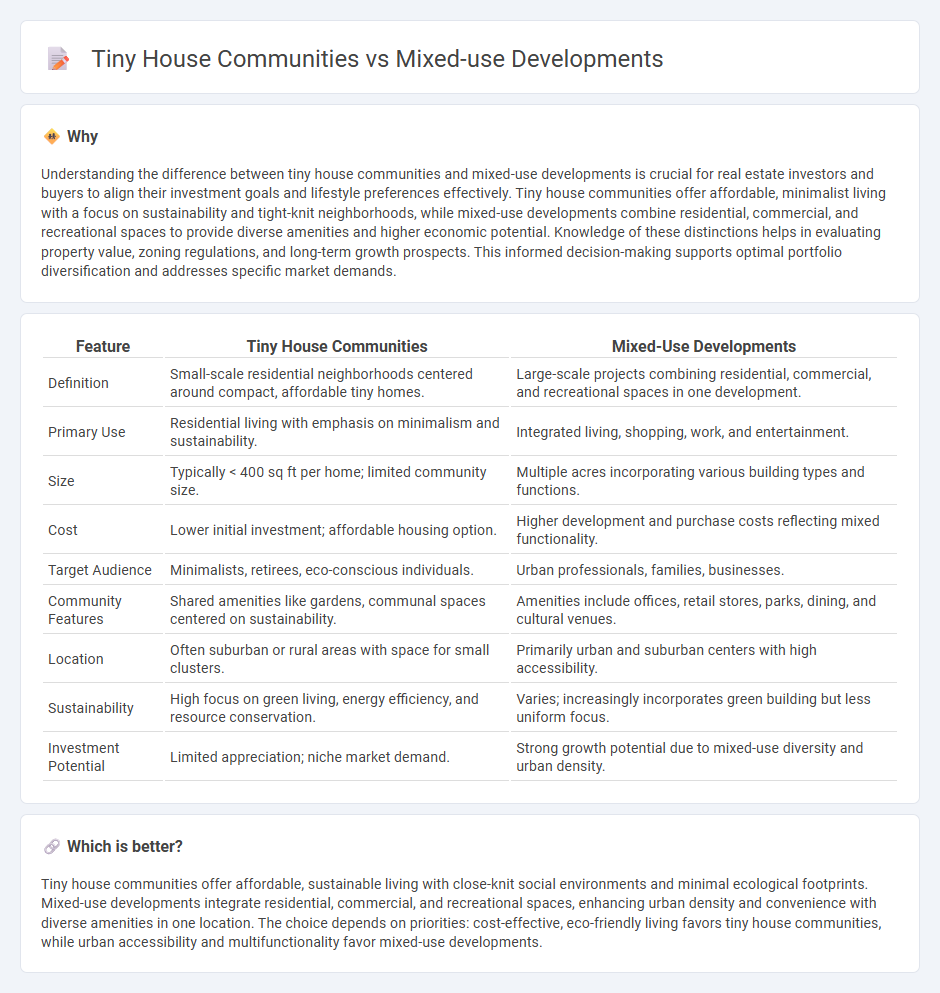
Tiny house communities offer affordable, sustainable living with close-knit social interaction and minimal environmental impact, appealing to those seeking simplicity and eco-friendly lifestyles. Mixed-use developments blend residential, commercial, and recreational spaces, creating vibrant urban environments that promote convenience, diversity, and economic growth. Explore the benefits and unique features of each to determine the ideal real estate investment for your lifestyle.
Why it is important
Understanding the difference between tiny house communities and mixed-use developments is crucial for real estate investors and buyers to align their investment goals and lifestyle preferences effectively. Tiny house communities offer affordable, minimalist living with a focus on sustainability and tight-knit neighborhoods, while mixed-use developments combine residential, commercial, and recreational spaces to provide diverse amenities and higher economic potential. Knowledge of these distinctions helps in evaluating property value, zoning regulations, and long-term growth prospects. This informed decision-making supports optimal portfolio diversification and addresses specific market demands.
Comparison Table
| Feature | Tiny House Communities | Mixed-Use Developments |
|---|---|---|
| Definition | Small-scale residential neighborhoods centered around compact, affordable tiny homes. | Large-scale projects combining residential, commercial, and recreational spaces in one development. |
| Primary Use | Residential living with emphasis on minimalism and sustainability. | Integrated living, shopping, work, and entertainment. |
| Size | Typically < 400 sq ft per home; limited community size. | Multiple acres incorporating various building types and functions. |
| Cost | Lower initial investment; affordable housing option. | Higher development and purchase costs reflecting mixed functionality. |
| Target Audience | Minimalists, retirees, eco-conscious individuals. | Urban professionals, families, businesses. |
| Community Features | Shared amenities like gardens, communal spaces centered on sustainability. | Amenities include offices, retail stores, parks, dining, and cultural venues. |
| Location | Often suburban or rural areas with space for small clusters. | Primarily urban and suburban centers with high accessibility. |
| Sustainability | High focus on green living, energy efficiency, and resource conservation. | Varies; increasingly incorporates green building but less uniform focus. |
| Investment Potential | Limited appreciation; niche market demand. | Strong growth potential due to mixed-use diversity and urban density. |
Which is better?
Tiny house communities offer affordable, sustainable living with close-knit social environments and minimal ecological footprints. Mixed-use developments integrate residential, commercial, and recreational spaces, enhancing urban density and convenience with diverse amenities in one location. The choice depends on priorities: cost-effective, eco-friendly living favors tiny house communities, while urban accessibility and multifunctionality favor mixed-use developments.
Connection
Tiny house communities and mixed-use developments are connected through their shared emphasis on maximizing land efficiency and fostering sustainable, walkable neighborhoods. Both prioritize compact living spaces and integrated amenities that support community interaction, reduce reliance on cars, and promote affordable housing options. This synergy aligns with urban planning trends focused on density, environmental sustainability, and vibrant local economies.
Key Terms
**Mixed-Use Developments:**
Mixed-use developments integrate residential, commercial, and recreational spaces within a single area, fostering vibrant, walkable communities that enhance urban living. These projects often boost local economies by attracting diverse businesses and increasing property values, while promoting sustainability through reduced reliance on cars. Discover how mixed-use developments are reshaping city landscapes and offering innovative solutions to modern urban challenges.
Zoning
Mixed-use developments benefit from flexible zoning laws that allow residential, commercial, and recreational spaces within a single area, promoting urban density and walkability. Tiny house communities often face strict zoning challenges, as many municipalities categorize them under single-family housing rules, limiting their placement and growth potential. Explore zoning regulations further to understand their impact on these innovative living solutions.
Live-Work-Play
Mixed-use developments seamlessly integrate residential, commercial, and recreational spaces to foster a dynamic Live-Work-Play environment that supports convenience and urban vitality. Tiny house communities emphasize sustainable living and affordability, often prioritizing minimalist lifestyles and close-knit social interaction within compact, efficient spaces. Explore how these models redefine modern living by balancing density, functionality, and community engagement.
Source and External Links
Supporting Active Living Through Mixed-Use Developments - This blog post discusses how mixed-use developments support active living by integrating various uses, fostering nonvehicular access and increasing physical activity in communities.
Benefits of Mixed-Use Development in Urban Areas - This article highlights the advantages of mixed-use developments in optimizing land use, promoting vibrant communities, and facilitating sustainable urban growth.
8 Different Types of Mixed-Use Development - This guide explores various types of mixed-use developments, including vertical, horizontal, live-work, retail-residential, and others, highlighting their features and contributions to urban environments.
 dowidth.com
dowidth.com